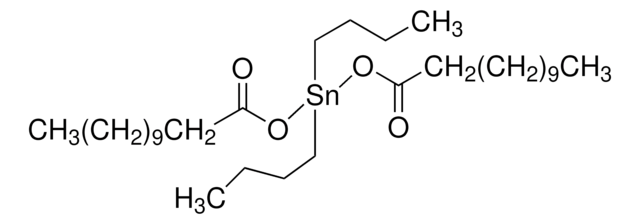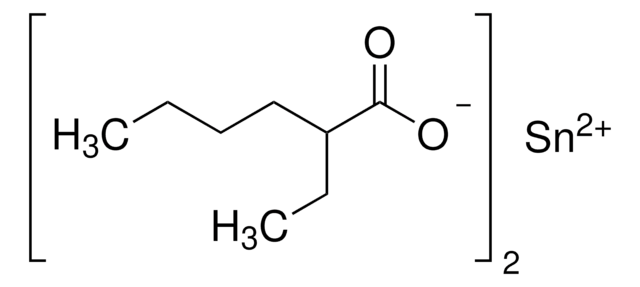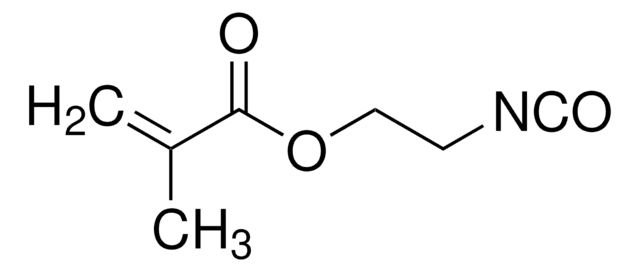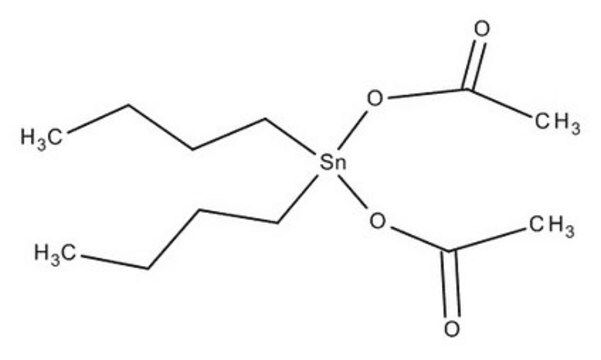8.20421
Dibutyltin dilaurate
for synthesis
Sinonimo/i:
Dibutyltin dilaurate, Dibutylbis(lauroyloxy)stannane, Dibutyl bis(lauroyloxy)tin
About This Item
Prodotti consigliati
Tensione di vapore
<0.1 hPa ( 20 °C)
Livello qualitativo
Forma fisica
solid
Temp. autoaccensione
>200 °C
Potenza
175 mg/kg LD50, oral (Rat)
P. eboll.
>250 °C/1013 hPa
Punto di fusione
25-27 °C
Temp. transizione
flash point 191 °C
Solubilità
<1.43 mg/L
Densità
1.05 g/cm3 at 20 °C
Temperatura di conservazione
2-30°C
InChI
1S/2C12H23O2.2C4H9.Sn/c2*1-2-3-4-5-6-7-8-9-10-11-12(13)14;2*1-3-4-2;/h2*2-11H2,1H3;2*1,3-4H2,2H3;
FWFWAXJCZAZGQD-UHFFFAOYSA-N
Applicazioni
- Planting carbon nanotubes onto supramolecular polymer matrices for waterproof non-contact self-healing: Discusses the use of DBTDL in creating advanced waterproof and self-healing materials, significant for innovations in material science and engineering (Li et al., 2019).
- Improvement of biodegradability of UV-curable adhesives modified by a novel polyurethane acrylate: Focuses on the role of DBTDL as a catalyst in enhancing the biodegradability of polyurethane acrylates, pertinent to environmental sustainability in chemical processes (Huang et al., 2016).
- A fluorinated polycarbonate based all solid state polymer electrolyte for lithium metal batteries: Investigates the catalytic role of DBTDL in synthesizing polymer electrolytes for energy storage applications, linking to advancements in battery technology and material science (Wang et al., 2020).
Risultati analitici
Identity (IR): passes test
Due to its specific melting range the product may be solid, liquid, a solidified melt or a supercooled melt.
Avvertenze
Danger
Indicazioni di pericolo
Consigli di prudenza
Classi di pericolo
Aquatic Acute 1 - Aquatic Chronic 1 - Eye Irrit. 2 - Muta. 2 - Repr. 1B - Skin Sens. 1 - STOT RE 1 - STOT SE 1
Organi bersaglio
thymus
Codice della classe di stoccaggio
6.1C - Combustible, acute toxic Cat.3 / toxic compounds or compounds which causing chronic effects
Classe di pericolosità dell'acqua (WGK)
WGK 3
Punto d’infiammabilità (°F)
372.2 - 379.4 °F - closed cup
Punto d’infiammabilità (°C)
189 - 193 °C - closed cup
Certificati d'analisi (COA)
Cerca il Certificati d'analisi (COA) digitando il numero di lotto/batch corrispondente. I numeri di lotto o di batch sono stampati sull'etichetta dei prodotti dopo la parola ‘Lotto’ o ‘Batch’.
Possiedi già questo prodotto?
I documenti relativi ai prodotti acquistati recentemente sono disponibili nell’Archivio dei documenti.
I clienti hanno visto anche
Il team dei nostri ricercatori vanta grande esperienza in tutte le aree della ricerca quali Life Science, scienza dei materiali, sintesi chimica, cromatografia, discipline analitiche, ecc..
Contatta l'Assistenza Tecnica.

















